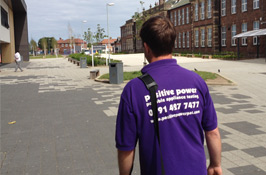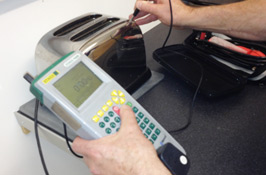What needs to be tested?
Portable Appliance EquipmentThere are many European standards and guidance notes regarding portable appliances and equipment, though they do not establish a common and specific definition of such equipment. Even so, there does seem to be a consensus of opinion that such equipment is either hand held whilst being connected to the supply, or is intended to be moved whilst connected to the supply, or is capable of being moved without undue difficulty whilst connected to the supply.
It is usual for this equipment to be connected to the supply via a plug and socket, however this is not a requirement for electrical equipment to be deemed portable or transportable. It is common to define a portable appliance by saying that it is 'anything with a plug top on the end of it'. This is a mistake as it may mean that there are some appliances in the system that are never tested.
The National Association of Professional Inspectors and Testers (napit) define a portable appliance as 'any electrical item which can or is intended, to be moved whilst connected to an electrical supply.'
The IEE Code of Practice gives guidance on the various equipment types:
Portable appliance
An appliance of less than 18kg in mass that is intended to be moved whilst in operation or an appliance which can easily be moved from one place to another, e.g. vacuum cleaner, toaster, food mixer, etc.
Movable equipment (transportable)
This equipment is either:
18 kg or less in mass and not fixed, e.g. electric fire.
or
Equipment with wheels, castors or other means to facilitate movement by the operator as required to perform its intended use, e.g. air conditioning unit
Hand Held equipment or appliances
This is portable equipment intended to be held in the hand during normal use, e.g. hair dryer
Stationary equipment or appliances
This equipment has a mass exceeding 18kg and is not provided with a carrying handle, e.g. refrigerator
Fixed Equipment/appliances
This equipment or an appliance which is fastened to a support or otherwise secured in a specific location, e.g. bathroom heater
Appliances/equipment for building in
This equipment id intended to be installed in a prepared recess such as a cupboard or similar. In general, equipment for building in does not have exposure on all sides because one or more of the sides, additional protection against electrical shock is provided by the surroundings, e.g. built in electric cooker
Information technology equipment
Information technology equipment includes electrical business equipment such as computers and mains powered telecommunications equipment, and other equipment for general business use, such as mail processing machines, VDU's photo-copiers
What type of test is done?
Each item undergoes a formal visual inspection to check for damage to the appliance, the lead and the plug.Encompassed within the inspection, the engineer will check that the appliance is being used in the type of environment for which it was designed and is not subject to undue wear and tear, for example extension leads being run across floors without protective casing.
If the appliance passes the visual inspection it will then undergo a series of instrumental tests, relevant to either Class I or Class II items. The tests may include:
- Earth continuity Test
- Insulation Resistance Test
- Polarity Test
- Operational Test (if possible)
- Earth Leakage Test
All failed items will be repaired immediately if the fault is minor, such as an incorrect fuse or damaged plug, and retested. There is no extra charge for these services. Those failed items with complex faults or serious damage will be reported to the relevant site contact.
How often should our appliances be tested?
Frequency of testing depends on the type of equipment and the environment in which it is used. The frequencies we recommend are based on the guidelines by the Health & Safety Executive (HSE), Institution of Engineering & Technology (IET). It is always wise to check with your insurance company as most will require an annual inspection.Does testing take place during office hours?
Positive Power will attend your premises at the time that suits your business, We can work along side your employees, we have experience in working in busy environments with minimal disruption. Or we can work out of office hours its your choice.How long has Positive Power been in business?
Positive Power is a J.I.B. approved electrical company that has been specialising in Portable Appliance Testing since 1992.Our extensive electrical knowledge combined with the vast experience we have in PAT Testing means that we are able to provide clients with an exemplary service, ensuring compliance with the Electricity at Work Regulations.
Are Postive Power engineers qualified and screened?
Our engineers are qualified to the City and Guilds PAT Testing-2377-20 we also have fully qualified Electricians on the team. Our engineers are Enhanced CRB checked as we specialize in the Education and Airport Business sectors where security checks are vital.Are There any additional Costs?
No, No charge is made for minor repairs including replacement plugs and fuses.Do we receive documentation?
Documentation containing the safety status and details of the test results for each appliance will be issued to the client after the data has been processed. This will be in the form of a physical document , CD ROM or whatever format you require.Finally, once the PAT Testing has been completed all data is held by Positive Power and we will contact you regularly in order to assist you with the continuance of your ongoing system of risk assessment and maintenance of electrical equipment.




